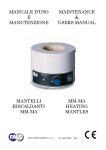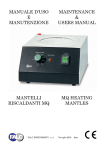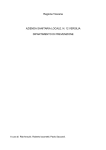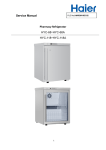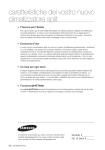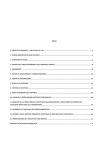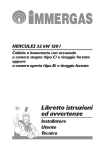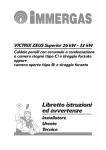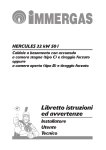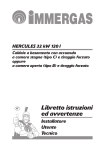Download manuale d`uso e manutenzione maintenance & users manual
Transcript
MANUALE D’USO E MANUTENZIONE MAINTENANCE & USERS MANUAL THERMOBLOCK DIGITALE DIGITAL THERMOBLOCK FALC INSTRUMENTS s.r.l. Treviglio (BG) Italy INDICE 1.0 SICUREZZA…………………………………………………………………………………. pag. 1 1.1 GENERALE………………………………………………………………………...…… pag. 1 1.2 QUALIFICA DELL’OPERATORE……………………………………………...……… pag. 1 1.3 SICUREZZA DELLO STRUMENTO…………………………………………………... pag. 1 1.4 RISCHI RESIDUI…………………………………. ……………………………………. pag. 1 2.0 OPERAZIONI PRELIMINARI…………………………………………………………….… pag. 1 2.1 VERIFICA DEI DANNI DOVUTI AL TRASPORTO…………………………….…….pag. 1 2.2 IN CASO DI DANNI……………………………………………………………………..pag. 1 2.3 PULIZIA DELLO STRUMENTO………………………………………………………. pag. 1 3.0 CARATTERISTICHE DELLO STRUMENTO………………………………………………pag. 2 4.0 COMANDI…………………………………………………………………………………… pag. 2 5.0 INSTALLAZIONE E PROCEDURA D’UTILIZZO………………………………………… pag. 3 5.1 CARATTERISTICHE FISICHE………………………………………………………… pag. 3 5.2 MESSA IN FUNZIONE…………………………………………………………………. pag. 3 6.0 USI PREVISTI E NON PREVISTI…………………………………………………………... pag. 4 7.0 MANUTENZIONE……………………………………………………………………………pag. 5 7.1 MANUTENZIONE DELLO STRUMENTO…………………………………………….. pag. 5 7.1.1 MANUTENZIONE ORDINARIA…………………………………………………. pag. 5 7.1.2 MANUTENZIONE PROGRAMMATA…………………………………………… pag. 5 7.2 PULIZIA………………………………………………………………………………….. pag. 5 7.2.1 ATTREZZI E PRODOTTI PER LA PULIZIA…………..………………………… pag. 5 7.3 TRASPORTO…………………………………………………………………………….. pag. 6 7.4 IMMAGAZZINAMENTO……………………………………………………………….. pag. 6 7.4.1 CARATTERISTICHE DI IMMAGAZZINAMENTO……………………………...pag. 6 8.0 RISOLUZIONE PROBLEMI………………………………………………………………… pag. 6 9.0 SCHEMA ELETTRICO ….………………………………………………….………………. pag. 7 10.0 DEMOLIZIONE………..…………………………………………………………………… pag. 10 10.1 QUALIFICA DELL’OPERATORE…..………………………………………………… pag. 10 10.2 DISATTIVAZIONE E DEMOLIZIONE………………………...……..………………. pag. 10 10.3 PROCEDURA DI DISATTIVAZIONE E DEMOLIZIONE……..…………………….. pag. 10 10.4 RISCHI RESIDUI DOPO LA DEMOLIZIONE…..………..…………………………... pag. 10 Questo manuale deve essere conservato per tutta la vita tecnica dello strumento in modo da essere facilmente reperibile in caso di necessità. In caso di vendita dello strumento usato dovrà essere venduto completo di questo manuale. Conservare il manuale in luoghi asciutti e facilmente accessibili per una rapida consultazione. Non sporcare il manuale per evitare di creare macchie che impediscano la lettura del testo. 1.0 SICUREZZA 1.1 GENERALE Nella progettazione e nella costruzione di questo apparecchio sono stati adottati i criteri e gli accorgimenti adatti a soddisfare i requisiti essenziali di sicurezza previsti dalla Direttiva Bassa Tensione 2006/95/CE. L’accurata analisi dei rischi svolta ha consentito di eliminare la maggior parte dei rischi connessi alle condizioni di uso dell’apparecchio, sia previste che ragionevolmente prevedibili. La documentazione completa delle misure adottate ai fini della sicurezza è contenuta nel fascicolo tecnico dello strumento, depositato presso il fabbricante. Il fabbricante raccomanda di attenersi scrupolosamente alle istruzioni, procedure e raccomandazioni contenute in questo manuale ed alla vigente legislazione sulla sicurezza nell’ambiente di lavoro, anche per l’utilizzo dei dispositivi di protezione previsti. FALC INSTRUMENTS non si assume responsabilità per eventuali danni a persone, animali o cose derivanti dall’impiego di operatori non qualificati e/o dall’uso improprio dello strumento 1.2 QUALIFICA DELL’OPERATORE Le operazioni di installazione dello strumento devono essere effettuate esclusivamente da personale addestrato, qualificato ed autorizzato, dopo aver studiato e capito il manuale d’uso. 1.3 SICUREZZA DELLO STRUMENTO Lo strumento è dotato di una segnalazione visiva del superamento del valore di set point. Quando la temperatura è superiore di 2°C rispetto al set point si accende la spia di allarme e si interrompe immediatamente il riscaldamento. Questa funzione è anche utilizzata per il raggiungimento della temperatura impostata. 1.4 RISCHI RESIDUI Durante l’utilizzo bisogna evitare che gli arti dell’utilizzatore entrino in contatto con le superfici calde dello strumento come la vaschetta di contenimento dei blocchi, i blocchi in alluminio o sostanze riscaldate. Si consiglia di utilizzare guanti o attrezzi adatti alla movimentazione di contenitori caldi. ATTENZIONE Il non utilizzo e/o la manomissione delle protezioni causa rischi per gli utilizzatori dello strumento e per altre persone esposte; per tanto FALC INSTRUMENTS non si assume responsabilità per eventuali danni a persone, animali o cose dovuti a questi comportamenti 2.0 OPERAZIONI PRELIMINARI 2.1 VERIFICA DEI DANNI DOVUTI AL TRASPORTO Verificare lo stato dello strumento tramite un’ispezione visiva dopo aver aperto l’imballo con delicatezza. Eventuali deformazioni delle parti visibili indicano urti subiti dallo strumento durante il trasporto, che potrebbero compromettere il normale funzionamento. In particolare verificare il buono stato delle seguenti parti: - Struttura dello strumento. - Comandi e spie. - Controllare il serraggio delle viti e dei bulloni. 2.2 IN CASO DI DANNI I danni dovuti al trasporto devono essere attribuiti al trasportatore e segnalati immediatamente al fabbricante o al suo responsabile. Inviare una lettera di contestazione al trasportatore. 2.3 PULIZIA DELLO STRUMENTO Togliere la polvere e lo sporco esterni accumulati durante le fasi di trasporto. 1 / 10 3.0 CARATTERISTICHE DELLO STRUMENTO Modello TD 150 P1 TD 150 P2 TD 150 P3 n° 1 2 3 Temperatura massima °C + 150 + 150 + 150 Precisione sul blocco 37°C ± 0,5 ± 0,5 ± 0,5 W 90 180 270 mm 220 x 185 x 95 220 x 225 x 95 220 x 325 x 95 Kg 2,2 2,8 3,6 621.0422.01 621.0422.02 621.0422.03 Posto per blocchi . Potenza riscaldante Dimensioni esterne LxPxH Peso . Codice ATTENZIONE Le temperature massime indicate si riferiscono all’interno del portablocchi. ATTENZIONE La taratura dello strumento viene effettuata a 37°C Alimentazione V/Hz 230/50-60 Classe di sicurezza 0 Classe di protezione IP 40 Custodia esterna in acciaio verniciata a forno con polvere epossidica antiacida, la vaschetta di contenimento dei blocchi è realizzata in alluminio in modo da assicurare una distribuzione uniforme del calore. Il controllo e l’impostazione dei valori avviene tramite un termoregolatore digitale con microprocessore ad azione PID e una sonda PT100 per una migliore precisione della temperatura. Il riscaldamento del thermoblock è costituito da resistenze poste al di sotto della vaschetta, tutti gli strumenti vengono dotati di un interruttore ON/OFF con luce verde. 4.0 COMANDI Serve per accendere e spegnere lo strumento. Visualizza la temperatura corrente o la Display temperature impostata. IG Interruttore generale IG Display Enter Enter Up Per ulteriori informazioni vedere capitolo 5.2 MESSA IN FUNZIONE a pag. 3. Down Conferma le modifiche effettuate. Up Incrementa la temperatura impostata. Down Decrementa la temperatura impostata. Si accende quando le resistenze sono in funzione o durante la fase di set. Si accende quando la temperatura è inferire all’impostazione. Si accende quando la temperatura è uguale all’impostazione. Si accende quando la temperatura è superiore all’impostazione. Si accende durante la fase di set o se il set point è superato di 2°C. 2 / 10 5.0 INSTALLAZIONE E PROCEDURA D’UTILIZZO 5.1 CARATTERISTICHE FISICHE Collocare lo strumento in luoghi ritenuti idonei per l’utilizzo (norma D.L.626/94 - c valutazione rischi). Oltre alle dimensioni di ingombro dello strumento, è necessario rispettare le seguenti condizioni: - In prossimità della zona di collocazione devono essere predisposte le fonti di alimentazione. Lo strumento ha un unico punto di alimentazione elettrica esterna posto sul retro. Verificare che la linea di distribuzione elettrica sia dimensionata in funzione della potenza dell’apparecchio e che sia provvista di impianto a terra (per i dati di tensione controllare l’etichetta posta sul retro dello strumento). __ - Prevedere uno spazio sufficiente ed in piano per il normale utilizzo e manutenzione dello strumento, compreso lo spazio per le eventuali apparecchiature periferiche. _____ _________ In oltre lo strumento deve essere collocato in un locale coperto e protetto dal contatto con gli agenti atmosferici. Per svolgere in sicurezza le fasi di lavorazione e di manutenzione dello strumento è necessaria una buona illuminazione. Una normale illuminazione ambiente permette di lavorare senza rischi dovuti a zone d’ombra. La temperatura ammessa per un normale funzionamento va da un minimo di +5°C ad un massimo di +40°C con umidità relativa massima 80% per temperature sino a +31°C con diminuzione lineare sino al 50 % alla temperatura di +40°C. ATTENZIONE FALC INSTRUMENTS declina ogni responsabilità per inconvenienti, guasti o malfunzionamenti che dovrebbero verificarsi in conseguenza del mancato rispetto delle indicazioni sopra citate. 5.2 MESSA IN FUNZIONE 1) ALLACCIAMENTI ELETTRICI Lo strumento ha un unico punto di alimentazione elettrica esterna, posto sul retro. 2) AVVIAMENTO DI PROVA Prima di procedere all’utilizzo ordinario e continuativo dello strumento verificare il perfetto funzionamento eseguendo almeno un ciclo completo di prova. 3) ACCENSIONE DELLO STRUMENTO - Inserire la presa del cavo di alimentazione nella presa posta sul retro dello strumento. - Inserire la spina del cavo di alimentazione nella presa della rete di alimentazione. - Portare in posizione “1” l’interruttore generale IG. Lo strumento inizierà a scaldare. 4) FASE DI SET - Premendo il tasto Up o Down compare il valore del SET POINT. - Utilizzare il tasto Up o il tasto Down per impostare il valore di temperatura desiderato. - Per memorizzare il nuovo valore si deve infine premere il tasto Enter. Se per quattro secondi non si preme alcun tasto il display torna ad indicare la temperatura corrente. In posizione centrale, sotto al display, è presente un indicatore di scostamento a tre LED: verde al centro e rossi i due laterali. Ci sono cinque possibili segnalazioni: 3 / 10 → La temperatura è inferiore di 1,5°C dal SET POINT. → La temperatura è entro -1°C dal SET POINT. → La temperatura è ± 0,5°C dal SET POINT. → La temperatura è entro +1°C dal SET POINT. → La temperatura è maggiore di 1,5°C dal SET POINT. 5) PROCEDURA DI ARRESTO DELLO STRUMENTO - Portare in posizione “0” l’interruttore generale IG. - Togliere dallo strumento i contenitori e i blocchi. ATTENZIONE movimentazione di oggetti caldi. - Sezionare lo strumento dalla linea di alimentazione. ATTENZIONE FALC INSTRUMENTS non si assume alcuna responsabilità per eventuali danni a persone, cose o animali derivanti dal mancato rispetto delle precauzioni prescritte o dal mancato utilizzo dei DPI prescritti. (Vedi capitolo SICUREZZA a pag. 1). 6.0 USI PREVISTI E NON PREVISTI ☺ USI PREVISTI Gli apparecchi sono progettati e realizzati per riscaldare a secco e mantenere la temperatura delle soluzioni. Gli apparecchi sono progettati e realizzati per trattare le sostanze normalmente utilizzate in laboratorio Gli apparecchi sono progettati e realizzati per essere utilizzati in laboratorio a fini professionali, industriali e didattici. Gli strumenti sono utilizzabili nel campo della biochimica, nel campo della microbiologia, nel campo dell’ematologia e nel campo della diagnostica. USI NON PREVISTI Sono usi non previsti tutti gli usi non esplicitamente indicati in USI PREVISTI Uso degli strumenti in condizione ambientali diverse da quelle indicate Uso di apparecchi in atmosfere di gas esplosivi Uso elettromedicale Lavaggio dello strumento con getti d’acqua Utilizzo di acidi e solventi a contatto diretto con lo strumento ATTENZIONE FALC INSTRUMENTS non si assume responsabilità per eventuali danni a persone, animali o cose dovuti ad un utilizzo non conforme agli usi sopra citati. 4 / 10 7.0 MANUTENZIONE 7.1 MANUTENZIONE DELLO STRUMENTO Eseguire le operazioni di manutenzione con lo strumento spento e scollegato dalla rete di alimentazione. Assicurarsi che lo strumento sia freddo prima di iniziare qualsiasi operazione. Far eseguire la manutenzione solo da personale specializzato, addestrato e abilitato all’uso, alla preparazione e alla manutenzione solo dopo aver letto attentamente e recepito le raccomandazioni e le istruzioni fornite in questa sezione. 7.1.1 MANUTENZIONE ORDINARIA Rientrano nella manutenzione ordinaria tutte quelle operazioni che possono essere eseguite dall’utilizzatore. Si tratta di operazioni di pulizia, di ispezione periodiche e preventive che consentono l’utilizzo in sicurezza dello strumento. 7.1.2 MANUTENZIONE PROGRAMMATA Rientrano nella manutenzione programmata tutte quelle operazioni che possono essere eseguite solo dal personale autorizzato. Si tratta di ispezioni periodiche preventive e di interventi sullo strumento. Qualora il personale autorizzato ed addestrato non sia in grado di risolvere un determinato problema contattare l’assistenza tecnica. 7.2 PULIZIA ATTENZIONE Eseguire le operazioni di pulizia con l’apparecchio spento e scollegato dalla rete di alimentazione. Al termine di ogni giornata lavorativa e/o ogni sezione di lavoro eseguire un’accurata pulizia dello strumento , in particolare delle seguenti zone: - Piastra e superficie superiore dello strumento. - Parte frontale dei comandi. - Superficie circostante allo strumento. - Pavimentazione della zona di lavoro 7.2.1 ATTREZZI E PRODOTTI PER LA PUILIZIA Per le operazioni di pulizia è sufficiente disporre di un normale detergente e di acqua. In caso di sporcizia dura da eliminare utilizzare Isopropanolo. ATTENZIONE Evitare l’uso di solventi che danneggiano la vernice e i materiali sintetici. In particolare evitare l’uso di benzina, diluente nitro-perclorato e trielina. 5 / 10 7.3 TRASPORTO Se il trasporto avviene su veicoli stradali con cassone aperto bisogna assicurarsi che lo strumento, il suo corredo e l’imballo siano completamente coperti con una copertura in plastica o equivalente per proteggerli da agenti atmosferici. 7.4 IMMAGAZZINAMENTO Le indicazioni contenute in questa sezione devono essere rispettate durante i periodi di immagazzinamento temporaneo dello strumento che si possono verificare nelle seguenti situazioni. Installazione dello strumento non immediatamente successiva la sua fornitura. Disinstallazione dello strumento e suo immagazzinamento in attesa di ricollocazione. 7.4.1 - CARATTERISTICHE DI IMMAGAZZINAMENTO Altitudine fino a 2000m. Intervallo di temperatura ammesso: da +5°C a +40°C. Umidità relativa massima 80% per temperature sino a 31°C con diminuzione lineare sino a 50% con temperatura di +40°C. Protezione adeguata da agenti atmosferici. Spazio richiesto sufficiente a effettuare le operazioni di sollevamento e trasporto in maniera sicura e agevole Piano di appoggio orizzontale con portata superiore alla massa dello strumento NON APPOGGIARE NESSUN OGGETTO SOPRA LO STRUMENTO 8.0 RISOLUZIONE PROBLEMI Guasto riscontrato Cause Lo strumento non si accende 1) Lo strumento non è ben collegato alla linea di alimentazione. 2) I fusibili posti sul retro nella presa sono bruciati. 3) Ci sono problemi nella linea di alimentazione. Lo strumento non scalda 1) Lo strumento è spento. 2) Il valore del set point è inferiore alla temperatura ambiente. 3) * Il termoregolatore digitale dello strumento non funziona correttamente ( contattare l’assistenza tecnica ). 4) * Le resistenze sono bruciate ( contattare l’assistenza tecnica ). * I guasti descritti sono riconducibili ad un utilizzo dello strumento non conforme alle procedure del manuale, alla vita tecnica dei vari componenti e all’usura del tempo. Qualora il personale autorizzato ed addestrato non sia in grado di risolvere un determinato problema contattare l’assistenza tecnica. 6 / 10 9.0 SCHEMA ELETTRICO MODELLO: TD 150 P1 NR A B C 7 / 10 COMPONENTI FUSIBILI PRESA AD INNESTO INTERRUTTORE BIPOLARE NR COMPONENTI D TERMOREG. TM FALC E SONDA PT100 F RESISTENZA IN MICA MODELLO: TD 150 P2 NR A B C COMPONENTI FUSIBILI PRESA AD INNESTO INTERRUTTORE BIPOLARE NR COMPONENTI D TERMOREG. TM FALC E SONDA PT100 F RESISTENZA IN MICA 8 / 10 MODELLO: TD 150 3P NR A B C 9 / 10 COMPONENTI FUSIBILI PRESA AD INNESTO INTERRUTTORE BIPOLARE NR COMPONENTI D TERMOREG. TM FALC E SONDA PT100 F RESISTENZA IN MICA 10.0 DEMOLIZIONE 10.1 QUALIFICA DELL’OPERATORE Operatore qualificato è chi ha letto e recepito i contenuti nel capitolo SICUREZZA a pag. 1 e i contenuti del capitolo DEMOLIZIONE a pag. 10. 10.2 DISATTIVAZIONE E DEMOLIZIONE Una volta raggiunta la fine della vita tecnica e operativa dello strumento, lo strumento deve essere disattivato. La messa fuori servizio e in condizioni di non essere più utilizzato per gli scopi per cui a suo tempo era stato progettato e costruito, deve poter comunque rendere possibile il riutilizzo delle materie prime che lo costituiscono. È necessario effettuare una disattivazione e una demolizione in sicurezza dello strumento ATTENZIONE FALC INSTRUMENTS non si assume alcuna responsabilità per danni a persone, cose o animali derivanti dal riutilizzo di singole parti dello strumento per funzioni o situazioni di montaggio differenti da quelle originali. 10.3 PROCEDURA DI DISATTIVAZIONE E DEMOLIZIONE Le operazioni di disattivazione e demolizione dello strumento devono essere affidate solo a personale adeguatamente addestrato ed equipaggiato. Spegnere lo strumento Scollegare le fonti di alimentazione Smontare le seguenti parti: - Parti elettriche. - Parti in plastica. - Piedini di supporto in resina. Nel caso di movimentazione dello strumento fare riferimento ai capitoli INSTALLAZIONE E PROCEDURA D’UTILIZZO pag. 3, TRASPORTO e IMMAGAZZINAMENTO pag. 6. 10.4 RISCHI RESIDUI DOPO LA DEMOLIZIONE Se le indicazioni della sezioni DISATTIVAZIONE E DEMOLIZIONE pag. 10 sono eseguite accuratamente, non esistono rischi residui dopo la disattivazione. ATTENZIONE Lo strumento è realizzato con materiali non biodegradabili. Portare lo strumento in un deposito autorizzato per lo smaltimento. 10 / 10 INDEX 1.0 SECURITY…………………………………………………………………………………. page 1 1.1 GENERAL…..………………………………………………………………….…...…. page 1 1.2 OPERATOR QUALIFICATIONS…......……………………………………………… page 1 1.3 INSTRUMENTS SECURITY…………………………………………….…………… page 1 1.4 RESIDUAL RISKS……………………………………………….…………………… page 1 2.0 PRELIMINARY OPERATIONS……………………………………………………..……. page 1 2.1 CHECK FOR DAMAGE DURING TRANSPORT……………………..……….……. page 1 2.2 IN THE EVENT OF DAMAGE…………………………………....………………….. page 1 2.3 CLEANING THE INSTRUMENT………………………….………………………….page 1 3.0 INSTRUMENTS CHARACTERISTICS……..………….………………………………… page 2 4.0 COMMANDS………………………………………………………………………….…… page 2 5.0 INSTALLATION AND USE PROCEDURES……………………………….……….…… page 3 5.1 PHYSICAL CHARACTERISTICS……...……………………….…………………… page 3 5.2 FUNCTIONING…………………………………………………..…………………… page 3 6.0 INTENDED AND UNINTENDED USES………...………….……………………………. page 4 7.0 MAINTENANCE..…………………………………………………………………..……... page 5 7.1 INSTRUMENTS MAINTENANCE………….………………………………….…….. page 5 7.1.1 ORDINARY MAINTENANCE…………………………………….……………. page 5 7.1.2 PROGRAMMED MAINTENANCE….……………………….………………… page 5 7.2 CLEANING…………………………………………………..………………………… page 5 7.2.1 CLEANING PRODUCTS………………………………...……………………… page 5 7.3 TRANSPORT…………………………………………….…………………………….. page 6 7.4 STORING………………..……………………….…………………………………….. page 6 7.4.1 STORING CHARACTERISTICS…………………...…………………….……... page 6 8.0 PROBLEM RESOLUTIONS………………………………………………………….…… page 6 9.0 ELECTRICAL WIRING DIAGRAM...………………………………………...….………. page 7 10.0 DEMOLITION………..…………………………………………………….…………….. page 10 10.1 OPERATOR QUALIFICTIONS………………………………….…………………... page 10 10.2 DEACTIVATING AND DEMOLITION…………………...……..…………..……… page 10 10.3 DEACTIVATING AND DEMOLITION PROCEDURES..……..……….………...… page 10 10.4 RESIDUAL RISKS AFTER DEMOLITION……..………..…….…………………… page 10 This manual should be conserved for the whole technical life of the instrument so that it can be easily consulted in case of need. If the instrument used should be sold, it should be sold complete of this manual. Conserve the manual in a dry and easily reachable place for rapid consultation. Do not stain the manual to avoid creating stains that could prevent the lecture of this test. 1.0 SECURITY 1.1 GENERAL Criteria and notions have been used in the construction of this instrument that guarantee that the instrument complies with the basic safety requirements under Low Voltage Directive 2006/95/EC and subsequent amendments. The accurate risk analysis carried out by the manufacturer means that the majority of risks connected with the use of the instrument have been eliminated. Full documentation of the adopted safety measures can be found in the technical file held by the manufacturer. The manufacturer recommends that the instructions, procedures and recommendations container in this manual, together with the security regulations in the working area, even for the use of the intended uses of protection. FALC INSTRUMENTS cannot be held liable for any eventual damage to property, personal injury or injury to pets arising from the use of the instrument by unqualified operators and/or improper use of the instrument. 1.2 OPERATOR QUALIFICATIONS This instrument must only be used by trained, qualified and authorised personnel fully familiar with the information contained in this manual. 1.3 INSTRUMENTS SECURITY The instrument is doted of a visual signal for the exceeding of the set point value. When the temperature is superior in respect to the set point of 2°C the alarm spy light lights up and the heating is interrupted immediately This function is also used for reaching the set temperature. 1.4 RESIDUAL RISKS Contact with the hot surfaces of the instrument such as the block holding tank, aluminium blocks or heated substances should be avoided by the users limbs. We advise to use gloves or suitable tools for moving the hot containers. ATTENTION The non use or/and tampering with the protections could cause risks to the instruments users or other persons exposed; therefore FALC INSTRUMENTS cannot be held liable for eventual damage to property, personal injury or injury to pets due to this behaviour 2.0 PRELIMINARY OPERATIONS 2.1 CHECK FOR DAMAGE DURING TRANSPORT Carefully remove the packaging and visually check the instrument for damage. Any dents in the visual parts indicate that the instrument has been knocked during transport, which could compromise it’s normal operation. Check specially for the good conditions of the following parts: - Instruments case. - Controls and pilot lights. - Check that all accessible screws and nuts are tight. 2.2 IN THE EVENT OF DAMAGE Damage due to transport must be attributed to carrier and notified immediately to the manufacturer or his representative. Send a damage claim letter to the carrier. 2.3 CLEANING THE INSTRUMENT Remove any dust or external dirt accumulated during transport. 1 / 10 3.0 INSTRUMENTS CHARACTERISTICS Model TD 150 P1 TD 150 P2 TD 150 P3 n° 1 2 3 °C +150 +150 +150 37°C ± 0,5 ± 0,5 ± 0,5 W 90 180 270 mm 220 x 185 x 95 220 x 225 x 95 220 x 325 x 95 Kg 2,2 2,8 3,6 621.0422.01 621.0422.02 621.0422.03 Places per block . Maximum temperature Precision per block Heating power External dimensions LxWxH Weight . Item ATTENTION The maximum indicated temperatures refer to the internal part of block holder. ATTENTION The instrument’s tare is available at 37°C Power V/Hz 230/50-60 Security class 0 Protection class IP 40 External casing in oven painted epoxy anti-acid powder paint, the block holder tank is in aluminium in order to assure a uniform heating distribution. Control and setting of the values comes by means of a PID action microprocessor digital thermoregulator and PT100 probe for a better precision of the temperature. The heating of the thermoblock is set up by resistances underneath of the block holder tanks, all instruments are doted of a green light ON/OFF switch. 4.0 COMMANDS General IG switch Enter Display Up Down For further information please see chapter 5.2 FUNCTIONING on page 3. Serves to switch on and off the instrument Visualizes the temperature value or Display the set temperature. Confirms the modifications carried Enter out. IG Up Increases the set temperature. Down Decreases the set temperature. Lights up when the resistances are in function or during the set phase. Interruttore generale IG Lights up when the temperature is inferior to the set temperature. Lights up when the temperature is the same as the set temperature. Lights up when the temperature is superior to the set temperature. Lights up during the set phase or if the set point is over 2°C. 2 / 10 5.0 INSTALLATION AND OPERATING PROCEDURES 5.1 PHYSICAL CHARACTERISTICS Position the instrument in a suitable place for use (norm D.L. 626/94-c risk valuation). Other than the overall dimensions, the instrument also requires the following conditions: - In the immediate vicinity of the instrument you must provide power sources. The instrument has only one electrical power point placed on the back of the same. Check that the electric power is suitable to the instruments power and that the same has a good ground earth (for tension information please see the label placed on the back of the instrument). __ - Provide a sufficient flat space for the normal use and maintenance of the instrument, and any peripheral equipment_____ _________ The instrument must be placed in a covered area, not exposed to the weather. Good lighting conditions for safe normal operation and maintenance of the instrument. The room were the instrument is used must be lighted sufficiently to allow for operation without risks due to areas in shadow. The accepted temperature for normal functioning is of a minimum of +5°C to a maximum of +40°C with maximum relative humidity of 80% for temperatures up to 31°C with linear reduction to 50% at 40°C. ATTENTION FALC INSTRUMENTS declines any responsibilities for inconveniences, malfunctioning and breakdowns which could be caused due to the non respect of the above mentioned indications. 5.2 FUNCTIONING 1) ELECTRICAL WIRING The instrument has only one electrical power point placed on the back of the same. 2) TRIAL RUN Before proceeding to the ordinary use of the instrument please control the perfect functioning of the same by carrying out one complete trial circle. 3) SWITCHING ON THE INSTRUMENT - Place the power cable switch into the power point placed on the back of the instrument. - Place the plug into the power socket. - Place the general IG switch to position “1”. The instrument will start heating. 4) SET PHASE - By pressing Up or Down buttons the SET POINT value will appear. - Use the Up or Down buttons to set the required temperature values. - To memorise the new values press the Enter button. If for four seconds no buttons are pressed the display will return to indicate the current temperature. In the middle, underneath the display, there is a three LED movement indicator: green in the middle and red the two lateral ones. There are five possible signals: 3 / 10 → The temperature is inferior to 1,5°C from the SET POINT. → The temperature is within -1°C from the SET POINT. → The temperature is ± 0,5°C from the SET POINT. → The temperature is within +1°C from the set point SET POINT. → The temperature is higher of 1,5°C from the set point SET POINT. 5) SWITCHING OFF PROCEEDURES - Turn to position “0” the general IG switch. - Remove from the instrument the containers and the blocks. ATTENTION movement of hot objects. - Unplug instrument from the mains. ATTENTION FALC INSTRUMENTS cannot be held liable for eventual damage to property, personal injury or injury to pets arising from the non observance of the prescribed precautions or from the non use of the prescribed DPI’s (See chapter SECURITY on page 1). 6.0 INTENDED AND UNINTENDED USES ☺ INTENDED USES The instruments are projected and built for dry heating and to maintain the temperature of solutions. The instruments are usable in the biochemical, microbiological, haematology and diagnostics field. The instruments are projected and built for treating substance normally used in laboratories. The instruments are projected and built to be used in laboratories for professional, industrial and teaching purposes. UNINTENDED USES Unintended uses are all those uses not clearly indicated in INTENDED USES. Use of the instruments in ambient conditions different to the indicated ones. Use of the instruments in explosive gas atmospheres. Electro medical uses. Washing the instrument with water jets. Use of acids or solvents in direct contact with the instrument. ATTENTION FALC INSTRUMENTS cannot be held liable for injury to property, personal injury, injury to pets arising from a use not in accordance with the above mentioned uses 4 / 10 7.0 MAINTENANCE 7.1 INSTRUMENTS MAINTENANCE Carry out the maintenance operations with the instrument switched off and unplugged. Make sure that the instrument is cold before staring any type of operation. Maintenance can be carried out in safety by expert personnel trained in and authorised for the use, preparation and maintenance of the instrument after having carefully read and fully understood the recommendations and instructions provided in this section. 7.1.1 ORDINARY MAINTENANCE By ordinary maintenance we mean all operations that can be carried out by the user. These consist in cleaning operations, periodic and preventive inspections which allow the use of the instrument in complete safety. 7.1.2 PROGRAMMED MAINTENANCE By programmed maintenance we mean all operation which can be carried out only by authorised personnel. These consist in periodic and preventive inspections on the instruments. Nevertheless if the authorised and trained personnel should not be able to resolve a determined problem, contact the technical assistance. 7.2 CLEANING ATTENTION Carry out cleaning operations with the instrument switched off and unplugged from the mains. After the end of each working day, thoroughly clean the instrument, especially the following parts: - Plate and superior surface of the instrument. - Frontal parts of commands. - Surfaces surrounding the instrument. - The floor around the working area. 7.2.1 CLEANING PRODUCTS For cleaning operations it is sufficient to have a normal detergent and industrial water. Only use isopropyl alcohol in case of stubborn dirt. ATTENTION Avoid the use of solvents that can damage the synthetic material or the paint work. In particolar avoid the use of benzine, perchlorate diluent and trichloroethylene. 5 / 10 7.3 TRANSPORT If the instrument is transported by opened motor vehicles, the packaged instrument and its fittings must be covered completely by a plastic tarpaulin or equivalent to protect against the weather. 7.4 STORING The indications contained in this section must be observed during temporary storage: Installing the instrument non immediately after being supplied.. Deactivating the instrument and its storage whilst waiting for relocation. 7.4.1 - STORING CHARACTERISTICS Up to 2000m. above sea level Accepted temperatures: from +5°C to +40°C. Maximum relative humidity 80% at temperatures up to 31°C with linear reduction to 50% at +40°C. Adeguate weather-proofing. Sufficient room to manoeuvre for safe and easy lifting and transport. Horizontal surface capable of bearing more than the weight of the instrument. NEVER PLACE OR REST ANY OBJECT ON THE INSTRUMENT 8.0 PROBLEM RESOLUTIONS Verified fault Cause The instrument does not work 4) The instrument is not connected properly at the mains. 5) The fuses placed on the back of the plug are burnt out. 6) There are some problems with the electrical line. The instrument does not heat 5) The instrument is switched off. 6) The value of the set temperature is inferior to the ambient temperature. 7) * The instruments digital thermo regulator does not work properly ( contact technical assistance ). 8) * The resistances are burnt ( contact technical assistance ). * The above described faults are attributed to the use of the instrument without using the manual procedures, to the technical life of the various components and long time use. In the event that the authorised and trained personnel are not able to resolve a determined problem please contact the technical assistance. 6 / 10 9.0 ELECTRICAL WIRING DIAGRAMM MODEL : TD 150 P1 NR A B COMPONENTS FUSES COUPLING SOCKET C TWO POLE SWITCH 7 / 10 NR COMPONENTS D TM FALC THERMOREGULATOR E PT100 PROBE F RESISTANCE MODEL : TD 150 P2 NR A B COMPONENTS FUSES COUPLING SOCKET C TWO POLE SWITCH NR COMPONENTI D TM FALC THERMOREGULATOR E PT100 PROBE F RESISTANCE 8 / 10 MODEL : TD 150 P3 NR A B COMPONENTS FUSES COUPLING SOCKET C TWO POLE SWITCH 9 / 10 NR COMPONENTS D TM FALC THERMOREGULATOR E PT100 PROBE F RESISTANCE 10.0 DEMOLITION 10.1 OPERATOR QUALIFICATIONS A qualified operator who has read and fully understood the contents of chapter SECURITY on page 1 and the contents of chapter DEMOLITIO” on page 10. 10.2 DEACTIVATING AND DEMOLITION Once the instrument has reached the end of its technical operation life, the instrument has to be deactivated. Putting the same out of function and putting the instrument in a condition not to be used any more for the scopes which it had initially been projected and constructed, it should, however, be possible for the raw materials of the same to be re-used. It is necessary for a deactivating and demolition to be carried out in security of the instrument. ATTENTION FALC INSTRUMENTS cannot be held liable for personal injury or injury to pets arising from the re-use of the single parts of the instrument or installation situations different to the original ones. 10.3 DEACTIVATING AND DEMOLITION PROCEDURES The activating and demolition procedures of the instrument have to be carried out only by fully qualified and trained personnel. Switch off the instrument. Disconnect the power sources. Dismantle the following parts: - Electrical parts. - Plastic parts. - Resin Support Feet. In case of movement of the instrument refer to chapter INSTALLATION AND OPERATING PROCEDURES on page 4, TRANSPORT and STORING on page 7. 10.4 RESIDUAL RISKS AFTER DEMOLITION If the indications of section DEACTIVATING AND DEMOLITION page 10, are accurately carried out, there are no residual risks after demolition. ATTENTION The instrument has bee constructed with non biodegradable material. Dispose of the instrument in an authorised deposit for the disposal. 10 / 10 . FALC INSTRUMENTS s.r.l. Via G. Monzio Compagnoni, 2 24047 Treviglio (BG) – ITALY Tel. +39-0363.304660 Fax +39-0363.304395 e-mail: [email protected] web site: www.falcinstruments.it OGGETTO: GARANZIA OBJECTO: GARANTIA Per garanzia si intende la pura e semplice sostituzione, per un periodo limitato a 12 mesi dalla data di consegna, delle parti risultate difettose per manifestati vizi di fabbricazione. Lo strumento dovrà pervenire franco nostro stabilimento (allegando possibilmente una breve descrizione del difetto riscontrato) e se i vizi saranno accettati, verrà riparato e spedito con spese di trasporto a carico nostro. Sono altresì esclusi dalla garanzia i particolari di normale usura (elementi riscaldanti). La garanzia decade qualora l’apparecchio presenti modifiche apportate, manomissioni, o comunque eseguite riparazioni da parte di persone non autorizzate. Por garantia entendemos la pura y simple sostituzion, durante un período limitado dde 12 meses a partir da la fecha de entrega, de las partes defectousas a causa de problemas de fabricación. El aparato deberá ser devuelto a nuestra fábrica ex-factory (posiblemente con una explicación incluida). Y el problema será verificado, el aparato será reparado y enviado por nosotros y los gastos del transporte correrán a nuestro cargo. La garantia no será válida si al controlar el aparato comprobamos que el mismo ha sido daňado o ha sido reparado por personas no autorizadas a reparar el mismo. FALC INSTRUMENTS s.r.l. OBJET: GARANTIE On entend par garantie la remplacement pur et simple pendant une période limité à 12 mois à compter de la date de livraison, de pièces s’avérant défectueuses en raison de défauts de fabrication manifestés. L’appareil devra parvenir franco notre usine (accompagné si possible d’un bref descriptif du défaut relevé) et si les défauts sont reconnus comme tels, sera réparé et expédié à nos frais. La garantie exclut par ailleurs toutes les pièces particulières sujettes à une usure normale (pièces chauffantes par exemple). La garantie décline toute responsabilité pour un appareil ayant subi des modifications, des altérations ou encore des réparations effectuées par des personnes non autorisé FALC INSTRUMENTS s.r.l. FALC INSTRUMENTS s.r.l. SUBJECT: GUARANTY For a period of 12 months from the date of delivery to the carrier. With the word “guaranty” we engage ourselves to substitute any and every faulty instrument, product components or part, due to faults or defect of our manufacturing process, not due to transport or misuse, as soon as we are informed and the item sent back to us for verification. The item should be sent back to us at your charge with a report explaining and describing the fault. When the problem has been verified and confirmed, the item shall be substituted or changed repaired and sent back to the customer free of charge. In a case the item has been tampered with, misused, or used not following the instructions, or in case wrong repair trials have been done on it, there shall be no guaranty whatsoever. FALC INSTRUMENTS s.r.l. Dichiarazione di conformità CE Declaration of CE conformity Costruttore/Manufacturer FALC INSTRUMENTS s.r.l. Via G. Monzio Compagnoni, 2 24047 Treviglio (BG) ITALY Dichiara che il seguente apparecchio è conforme alle normative di Sicurezza concernente le DIRETTIVE CE per la COMPATIBILITÀ ELETTROMAGNETICA (2004/108/CE) e la BASSA TENSIONE (2006/95/CE). The following unit complies with the safety requirements outlined by the EC DIRECTIVE concerning the guidelines for ELECTROMAGNETIC COMPATIBILITY (2004/108/EC) and LOW VOLTAGE REGULATIONS (2006/95/EC). Lo strumento è costruito secondo la normativa The units are manufactured in compliance with the regulations CEI EN 61000-6-2 CEI EN 61000-6-4 CEI EN 61010-1 CEI EN 60355-1 CEI EN 61326-1 Il responsabile legale / legal responsable Scotti Francesco 1 / 10 revisione manuale 1.1.1 / manual revision 1.1.1




























